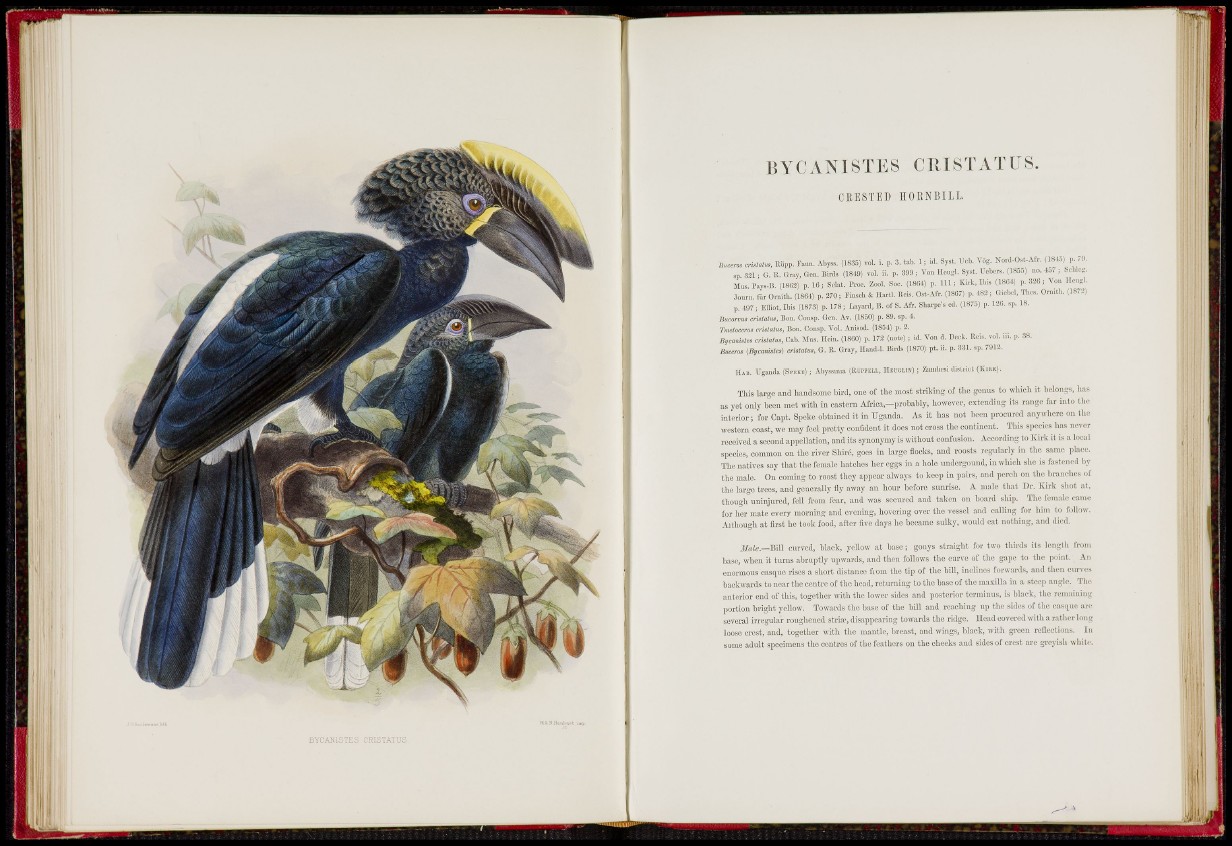
• i !i
B Y C A N IS T li S C R IS T A1' U S.
CRESTED HOKNBILL
B „ t™ C M , . , lliipp. ta. Aby«. (1835) vol. i. p. 3. W>. 11 « . ^ Urt. VHt N,>rd-0,t-Ai,. (18B) p. ,).
,p 321, G. K. Gray. G.u, Bml. (1819) ™1. ii. p. 399 j Vo„ H c s l . Sy.l. tJcl»r.. (1855) no. 167 j Scl.lcs.
Mu..l>.y.-B. (1862) p.W; Solal. Proc. Zool. SOB. (1861.) p. I l l ; Ki.-k, Il,is (1861) p. .326 I Von Iloot'l.
Jonm. fe Oraitli. (1864) p. 270; I t a l , & H.rtl. Hoi,. 0.t-A(,. (1867) p. 182; Oioliel, Tl,». On„U,. (1872)
p. 497; Elliot, Ibi, (1873) p. 178; Liy«ri, B. of S. Aft. Sh.rpo'. al. (1876) p. 126. ,p. 18.
Bu^nrvus cri^lnliis, Bon. Consp. Gen. Av. (1850) p. 89. sp. 4.
Tmelocei'0.1 cristatus, Bon. Consp. Vol. Anisod. (1854) p. 3.
JSlcanUa r.M„, Cab. Mn>. Iloin. (1860) p. 172 (aoto) ; id. Von .1. Dock. Eoi,. vol. iii. p. 38.
fc,™. {B,jca,i,la] mmm, Q. K. Gray, Iland-l. Bird, (1870) pi. ii. p. 331. .p. 7012.
LLAII. Uganda (SPEKB) ; Abyssinia (BiirPiiLr., IIBUGLIS) ; Zambosi district (KIHK).
This k rgo and handsoino bird, one of tlio most s t l i ldn; of tlio gonns to wliicli it belongs, has
a . yet only been mot with i n eastern Afpiea,—probably, hoivever, ei tending its range far int o the
interio r ; for Oapt. Spelto obtained it i n Uganda. As it has not been p t o e nml anywhere on the
western eoast, we may feel pret t y oonfident it does not eross the continent. This speeies hits never
reeeived a second appellation, and its synonymy is wi thont eonfnsion. According t o K i r k it is a local
species, common on the river Shire, goes in large flocks, and roosts regularly in the same pla<;e.
The natives say that the femal e liatches her eggs in a hole nndergoand, in which she is fastened by
t h e male. On coming to roost they appear always to keep in pairs, and perch on the branches of
t h e large trees, and generally ily away an honr before sunrise. A male that Dr. Kirk shot at,
t h o u g h uninjured, fell from fear, and was secured and taken on board ship. The female came
for her mat e every morning and evening, hoveling over the vessel and calling for him to follow.
A l t h o u g h at first he took food, after five days he hecame sulky, would eat nothing, and died.
J M e . — l ! i U eurved, black, yellow at base; gonys straight for tivo thirds its length from
base, when it turns abruptly upwards, and then follows the eurve of the gape to the point. AD
enormous casque rises a short distance fiom the tip of the hill, iuelines forwards, and then cm-v(;»
backwards to near the cent r e of the head, returning to the base of the maxi l l a in a steep angle. 'I'he
a n t e r i o r end of this, together with the lower sides and posterior terminus, is black, the remaining
p o r t i o n bright yellow. Towards the base of the bill and reaching up the sides of the easqiic are
several irregular roughened stria', disappear ing towards the ridge. Head covered wi t h a rather long
loose erest, and, together with the mantle, breast, and wings, black, wi t h green reflections. In
some adul t specimens the centres of the feathers on the cheeks and sides of crest are greyish white.
BYCAK;R.TES CRISTATUS